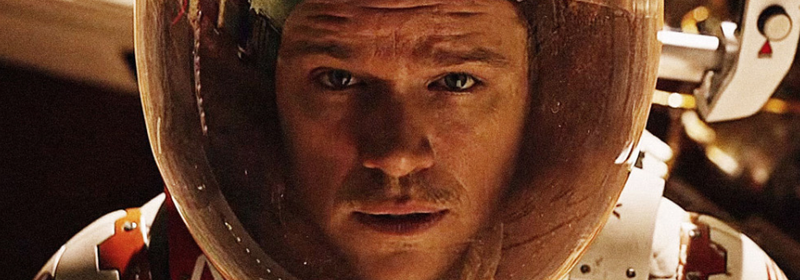
Fact, Fiction, or Future: The Martian Code
Article Header
« Return to Main PageFact, Fiction, or Future: The Martian Code

Courtesy of 20th Century Fox
In your face, Neil Armstrong!
–Mark Watney
Introduction
In 2011, science fiction fans everywhere were treated to a literary feast. Andy Weir’s The Martian became a near instant bestseller and catapulted its obscure author to fame. Four years later, The Martian was adapted into an award-winning film directed by sci fi legend Ridley Scott. The book tells the story of astronaut Mark Watney, a botanist and mechanical engineer of the Ares 3 mission to Mars. During a sandstorm, the crew is forced to abort the mission. In the process, Watney is struck by flying debris, and the crew are forced to leave him behind. He wakes up alone with no way to contact Earth and must survive for nearly four years before he can be rescued. The Martian is one of the most realistic science fiction novels of all time with its author doing extensive research before its publication. One of things fans enjoy about it the most is Watney’s ingenuity and optimism. This article discusses one of Watney’s more ingenious solutions: regaining contact with NASA. If you have not read the book or seen the film, spoilers follow. You have been warned!
No Antenna
Watney is left on Mars without a working communication system. However, the last man on Mars has a plan. Over the past few decades NASA has launched countless missions to the red planet including a number of rovers. One of the most famous (and most relevant to this book) is the Mars Pathfinder Mission with its Sojourner Rover. Pathfinder was launched December 4, 1996 from Cape Canaveral, Florida. According to NASA, from landing until the final data transmission on September 27, 1997, Mars Pathfinder returned 2.3 billion bits of information, including more than 16,500 images from the lander and 550 images from the rover, as well as more than 15 chemical analyses of rocks and soil and extensive data on winds and other weather factors. It is this ability to send data back to earth that Watney exploits.
Digging Up the Past
In the book, Watney tricks out one of the rovers the crew was given for transportation allowing it to go much longer distances. He drives this rover to the last known location of Pathfinder and digs it up. Watney returns to the Hab (the mission’s base) and is able to get the Pathfinder communication antenna working again. However, while the rover can communicate with earth, it only has a still motion camera. Watney is forced to come up with a way for NASA to communicate with him using only the camera’s movement.

Courtesy of 20th Century Fox
Watney’s Code
The Pathfinder’s still motion camera can turn 360°. Watney decides to stick posts in the ground around the camera. On each post, he puts a small sign with writing. This will allow NASA to point at what letter it means. However, in Watney’s words, “I can’t just use the letters A through Z. Twenty-six letters plus my question [mark] card would be twenty-seven cards around the lander. Each one would only get 13 degrees of arc. Even if JPL [NASA’s Jet Propulsion Lab] points the camera perfectly, there’s a good chance I won’t know which letter they meant” (Weir 119). At an impasse, Watney instead decides to use ASCII code.
ASCII is how computers store code. It assigns a special number to each symbol or letter of the Alphabet similar to a cipher. However, these numbers are in what is called Base 16 or hexadecimal. When normally counting, Base 10 (numbers 0-9) are used. Computers instead use Base 16 (0-9, A, B, C, D, E, F). A comparison between the two is shown in Table 1 below.

ASCII characters go from 0 to 255 with each hexadecimal number representing a new character. Since there only needs to be sixteen cards instead of twenty-seven, the camera’s turns are more obvious with an arc of 21 degrees.
Message from Earth
The first message Watney receives from NASA is the simple question “STATUS” (Weir 120). This word in ASCII code which Watney then translates is shown in Table 2 below.

By matching the hexadecimal number to the right character, NASA is able to communicate with Watney. Now you try, using the ASCII table below, to solve some of the messages to Mark Watney. The answers will be given at the end of the article. Try them first though; it’s the best way to learn.

Wikicommons
Question 1: 48 4F 57 41 4C 49 56 45
Question 2: 43 52 4F 50 53 3F
Question 3: 57 45 53 41 57 5F 53 41 54 54 45 4C 49 54 45
God’s Gift of Language
Language is fascinating. According to Genesis, language is a something God created and can change. However, being in the image of God, mankind can also create languages. ASCII is a human created language. All on the coding languages used for programming are also human inventions. Some fiction authors, most notably J.R.R Tolkien, have created entire fictional languages just for their own stories! Language can be used for praise, mockery, kindness, wickedness, truth, lies, joy, sorrow, and many more. God explains in Proverbs 12:18-19, “18 The words of the reckless pierce like swords, but the tongue of the wise brings healing. 19 Truthful lips endure forever, but a lying tongue lasts only a moment.” Language is a gift from God to be used for Him. Mark Watney needed NASA’s help and wisdom to survive on Mars. Mankind needs God’s help and wisdom to survive life. The most important time spent in a day is communicating with God and seeking His help. God has also given the gift of language that believers may tell others about Him. After spending some time with God today, go out and tell someone else about Him! You will be glad you did.

Works Cited:
Weir, Andy. Martian: Classroom Edition. Broadway Books, 2016. Print.









